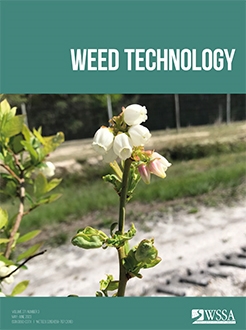Cereal rye cover crop (cereal rye) and preemergence (PRE) herbicides are becoming common practices for managing herbicide-resistant weeds in soybean production. Adopting these two practices in combination raises concerns regarding herbicide fate in soil, given that the cereal rye biomass can intercept the herbicide spray solution, preventing it from reaching the soil. Delaying cereal rye termination until soybean planting (planting green) optimizes biomass accumulation but might also increase PRE interception. To better understand the dynamics between cereal rye and PRE herbicides, a field experiment was conducted to evaluate two soil management practices (tillage and no-till) and two cereal rye termination practices in the planting-green system (glyphosate [1,260 g ae ha–1] and roller-crimper) on the spray deposition and fate of PRE herbicides and soybean yield. The spray deposition was assessed by placing water-sensitive paper cards on the soil surface before spraying the PRE herbicides (sulfentrazone [153 g ai ha–1] + S-metolachlor [1,379 g ai ha–1]). Herbicide concentration in soil (0 to 7.6 cm) was quantified 25 d after treatment (DAT). The presence of no-till stubble and cereal rye biomass reduced the spray coverage compared to tillage at PRE application, which reflected in a reduction in the concentration of both herbicides in soil 25 DAT. Soybean yield was reduced in all three years when the cereal rye was terminated with a roller-crimper but only reduced in one year when terminated with glyphosate. Our findings indicate that mainly cereal rye biomass reduced the concentration of PRE herbicides in the soil due to the interception of the spray solution during application. Although higher cereal rye biomass accumulation can provide better weed suppression according to the literature, farmers should be aware that the biomass can lower the concentration of PRE herbicides reaching the soil, thus intensifying field scouting to ensure that weed control is not being negatively affected.
Nomenclature: sulfentrazone; glyphosate; S-metolachlor; cereal rye, Secale cereale L.; soybean, Glycine max (L.) Merr.






